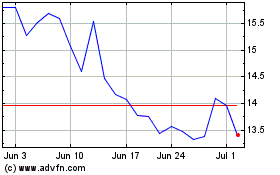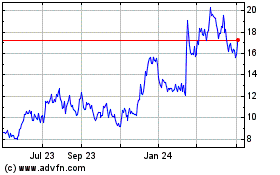Lyft Reports Strong Revenue Growth, $1.1 Billion Loss--2nd Update
May 07 2019 - 6:07PM
Dow Jones News
By Eliot Brown
Lyft Inc. posted strong growth in its first quarterly report as
a public company, with revenue nearly doubling from the year
before, even as losses continued to mount.
The San Francisco-based ride-hailing company reported revenue of
$776 million in the first three months of the year, up 95% from a
year earlier and better than many analysts expected.
Lyft's loss ballooned to $1.1 billion, largely due to $859
million of stock-based compensation -- an expense related to the
company's initial public offering in March. The company said its
adjusted loss was $211.5 million, versus $228.4 million a year
earlier. Analysts surveyed by FactSet expected an adjusted loss of
$274 million.
The results marked a solid debut for Lyft, which has aimed to
portray itself as the faster-growing ride-hailing service compared
with its much larger rival, Uber Technologies Inc. An IPO for Uber
is expected Friday, and Lyft got ahead of the event also announcing
an extended partnership with Alphabet Inc.'s self-driving car unit
Waymo, which said Tuesday it is letting people hail its robot taxis
through the Lyft app in the Phoenix area.
Uber's revenue growth -- roughly 20% in the first quarter -- has
been hampered by a barrage of competitors around the world. Still,
much of Lyft's growth appears to be a result of expansion of the
U.S. ride-hailing market, rather than stealing customers from Uber,
and that bodes well for both companies. Lyft's market share was
relatively stable in the first quarter, hovering around 30%,
according to Second Measure Inc., which analyzes a sample of U.S.
credit-card data.
Lyft's stock fell about 4% in after-hours trading to $57,
continuing its slide since the IPO in late March. The company's
shares are down about 20% from their debut price. A handful of
downbeat analysts reports and rumors of high short-selling interest
in the company may have caused some investors to lose confidence in
the stock.
The disappointing stock performance looms over Uber's impending
IPO, expected to be one of the largest ever for a technology
company, with a valuation up to $90 billion. Lyft and Uber are
among a parade of maturing Silicon Valley startups that are heading
to the public markets with historic losses.
For Lyft and Uber, some investors have shown a willingness to
overlook the record-setting losses, betting that the market for
ride-hailing is going to rack up strong growth for years -- -and
that both companies will eventually figure out how to become
profitable. Still, Lyft in aggregate loses money on every ride,
even when excluding costs like research and development and
administrative expenses, a trend that analysts expect to continue
for some time.
Some of those losses have come as a result of rider and driver
subsidies -- a practice that continued in the first quarter as Lyft
showered discounts on riders ahead of its IPO. The company spent
$227 million on sales and marketing, excluding stock-based
compensation expenses, up 34% from the prior year.
Its stock-based compensation expenses were higher than expected
by many analysts. Lyft accounted for much of the costs in its
expenses for research and development, encompassing rich stock
awards for its software engineers.
Lyft expects revenue growth to slow in the second quarter and
the rest of 2019 after it waged a price war with Uber last year
that raised fares. It projects revenue of at least $800 million in
the second quarter, up roughly 60% from a year ago, and as much as
$3.3 billion for the year. Both amounts are above what analysts had
been expecting.
Write to Eliot Brown at eliot.brown@wsj.com
(END) Dow Jones Newswires
May 07, 2019 17:52 ET (21:52 GMT)
Copyright (c) 2019 Dow Jones & Company, Inc.
Lyft (NASDAQ:LYFT)
Historical Stock Chart
From Aug 2024 to Sep 2024

Lyft (NASDAQ:LYFT)
Historical Stock Chart
From Sep 2023 to Sep 2024
